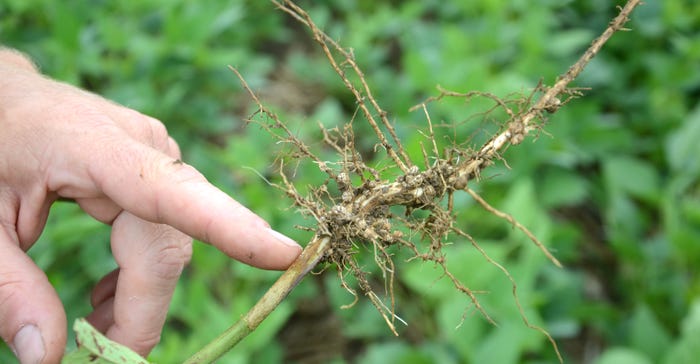
After receiving 6 or 8 inches of rain, or even more, in a month, some growers across the state began noticing that parts of their soybean fields seemed lighter in color and “just weren’t taking off.” The impact was less pronounced in the Soybean Watch ’21 field; while receiving more rain than needed, rainfall amounts weren’t among the highest totals reported.
“Most of the field was dark green in mid-July, and I was impressed by the overall amount of root mass and number of big, active nodules on most plants,” says Steve Gauck, a regional agronomy manager for Beck’s, sponsor of Soybean Watch ’21. “The length of some of the taproots we were able to pull up was impressive. These were soybeans no-tilled into cornstalks on May 15.”
Related: One surefire way to know it’s a wet season
In the Soybean Watch ’21 field, there were relatively small patches of lighter-colored beans scattered diagonally across the field. The grower observed that they somewhat corresponded with wetter soils in the field. The field has some older clay tile but has never been pattern-tiled.
Gauck pulled a plant from one of those areas and compared it to a plant from the darker green areas that dominated the field.
“We couldn’t find any significant disease symptoms on the plant,” he notes. The biggest difference was that the root system wasn’t as big. Surprisingly, there was still a good number of nodules on roots from the plant in the lighter area, but they weren’t as large or as numerous as nodules on roots from the plant in the darker green area of the field.

Gauck suspects that while rhizobium bacteria are establishing nodules and pulling nitrogen from the air even where soils are wetter, they aren’t as numerous. So, overall, they aren’t as effective. He intends to keep an eye on those areas and see if they green up if it dries out later in the season.

Some people with smaller, later-planted beans that seem to have been affected most by the heavy rains in July may attempt to add small amounts of nitrogen to kick-start them. The problem, Gauck says, is that you don’t want to add so much nitrogen that the nodules that are there become lazy and go to sleep. He believes once soils dry out, nodules in most of those areas will pick up in activity.
About the Author(s)
You May Also Like




